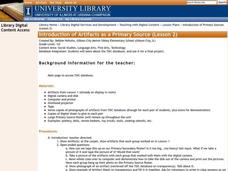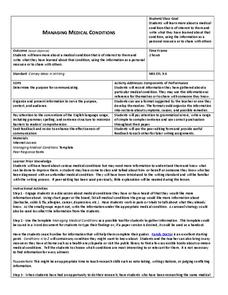Curated OER
Our Animal Friends
Students use the internet to find information pertaining to the benefits of pets. They list their results on a database. They find and record data on the percent of households that own pets as well as the top six species of pets. Once...
Curated OER
Create a Survey and Analyze the Data
Eighth graders create their survey discussing wording used in surveys and try to create one that is unbiased. They distribute the survey to the middle school but not during instructional time. They then collect and analyze the data...
Curated OER
Recipes from Africa and Asia
Seventh graders research Internet sites that provide recipes from Asian and African countries. They compile the recipes in a database. After compilation, they can sort the database for similarities and differences in ingredients.
Curated OER
Famous Black Americans
Students recognize famous Black Americans and their roles in America's society. They create a database and slideshow presenting famous Black Americans and relevant facts of their lives.
Curated OER
Weather Wise
Students investigate weather and how to forecast it. They discuss the three types of clouds and the kind of weather they bring. After setting up a database, they reearch weather-related websites to check cloud conditions and weather...
Curated OER
Western Hemisphere
Fourth graders use a database to compare countries in the western hemisphere. They describe a variety of regions in Texas and the Western Hemisphere such as political, population, and economic regions that result from patterns of human...
Curated OER
Comparing Weather Conditions
Students conduct research on temperature, wind speed and weather conditions from a variety of areas. They organize their findings on worksheets and spreadsheets and discuss various examples of databases.
Curated OER
Geography Grid
Fourth graders search a database to find images and scan and affix them on an 8-foot long map of the state of Illinois. They then use it as a basis for discussion.
Curated OER
Introduction of Primary Sources
Students will use the internet to access information about artifacts to justify their use as primary sources of information. The activities can be done as a whole class or in groups. The differences between primary and secondary sources...
Curated OER
Animal Playing Cards
Students research animal characteristics including information about mammals, reptiles, birds, and fish. They place the information into a database and then, create playing cards using the information.
Curated OER
Earth Day
Third graders utilize technology to access, analyze, interpret and communicate information about Earth Day.
Curated OER
Earth Day
Students examine evidence on Global Warming and then analyze the impact of their school community on the environment and propose ways to lessen our impact on the environment. They have access to a total of six articles for their...
Curated OER
Where Have All the Road Salts Gone, Long Time Migrating
Young scholars examine what happens to road salt after it is applied to the road during a storm. In groups, they collect their samples using a conductivity meter and enter their data into a database. They analyze and discuss the data...
Curated OER
Using The Catalog to Locate Information
Fourth graders identify prior knowledge of the Public Access Catalog. They identify parts of a catalog record. Students use the Public Access Catalog to locate an item. The teacher place 6-8 books on the tables. Students locate several...
Curated OER
Local Heart Rates
Students determine the type of data needed to test their inferences. As homework, they check and record heart rates of fellow students, teachers and family members. During their next class period, students enter all data into the database.
Curated OER
Chinese communities, Federation and the early Commonwealth
Students search and use a database. They compare and analyze primary sources and develop an awareness of the nature and extent of the Chinese community's involvement in the Federation celebrations.
Curated OER
An Early Canadian Photo Album
Students search the Images Canada database for images depicting life in Canada in the late 19th and early 20th centuries. They analyze photos and share their findings. They use these images to create a photo album.
Curated OER
Fluctuations in the Price of Oil
Young scholars examine the fluctuating gas prices and the effect it has on the Canadian economy by reviewing an online database that contains information on the retail price of gas for Canada's largest cities.
Curated OER
Must Love Animals!
Students research an animal and present their findings in an AppleWorks slideshow using computers, internet access, and Inspiration educational software. This instructional activity is intended for a middle-level Language Arts or...
Curated OER
Understanding URLs
Ninth graders explore the different domain suffixes in the web site address, how to find the author or sponsor of a page to determine authority and accuracy. They determine how currency of a page. Students enter the lab, log onto...
Curated OER
My Favorite Story
Students share their pictures on an online database. As a class, they discuss their favorite books and why they like it. They review the elements of a story and brainstorm ideas for each category. To end the lesson, they complete a...
Carolina K-12
African Americans in the United States Congress During Reconstruction
The Civil Rights Act of 1866, which granted citizenship to all males in the U.S., resulted in the first African Americans to be elected to Congress. Class members research 11 of these men, the challenges they faced, and craft...
Curated OER
The Internet Pizza Server - Pizza Simulation
Learners simulate going to a pizza restaurant, ordering a pizza, and determining whether a small, medium, large, or family size pizza is a "better-buy." Students calculate the price/per/topping and determine whether this price is "fair"
Curated OER
Managing Medical Conditions
Your scholoars practice organizing and presenting information through written language. They gather information about a medical condition and share it with someone else. They then use a format where they organize their information using...

























